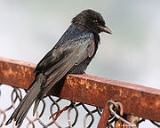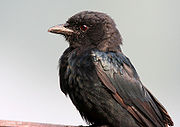
Ashy Drongo
Encyclopedia
The Ashy Drongo is a species of bird
in the drongo
family Dicruridae. It is found widely distributed across South and Southeast Asia with several populations that vary in the shade of grey, migration patterns and in the size or presence of a white patch around the eye.
 The adult Ashy Drongo is mainly dark grey, and the tail is long and deeply forked, There are a number of subspecies varying in the shade of the grey plumage
The adult Ashy Drongo is mainly dark grey, and the tail is long and deeply forked, There are a number of subspecies varying in the shade of the grey plumage
. Some subspecies have white markings on the head. Young birds are dull brownish grey.
Subspecies longicaudatus of India (which includes beavani of the Himalayas that winters on the peninsula, with one breeding population in central India that Vaurie separates as longicaudatus in the restricted sense) is very dark and almost like the Black Drongo
although this bird is slimmer and has a somewhat longer and less-splayed tail. It is found in more tall forest habitat, has dark grey underside lacking the sheen of Black Drongo. The iris is crimson and there is no white rictal spot. Subspecies leucogenis and salangensis have a white eye-patch as do several of the island forms that breed further south. The calls are a little more nasal and twangy than that of the Black Drongo.
from eastern Afghanistan
east to southern China
and Indonesia
. Many populations in the northern part of its range are migratory
. Charles Vaurie
described subspecies beavani (after Robert Cecil Beavan
) as the population that breeds along the Himalayas that wintered in peninsular India. However later workers include this as part of longicaudatus which also has a population that breeds in central India. In winter, the species is particularly fond of hill forests. E. C. Stuart Baker
described stevensi which Vaurie considered as being either beavani or hopwoodi of the eastern Himalayas. To the east of the range of hopwoodi is mouhouti of Thailand and Myanmar. To the north of this range are leucogenis and salangensis (both migratory mainly to areas further south but also known to the west in Nagaland) while bondi is found to the south. Along the southeast Asian island chain, there are number of insular populations including periophthalmus, batakensis, phaedrus, siberu and nigrescens. The nominate form is said to be found on Simalur, Java, Bali, Lombok, Palawan, and Balabac Islands.
A common call that they make is described as drangh gip or gip-gip-drangh. They can imitate the calls of other birds and are capable of imitating the whistling notes of a Common Iora
.
The breeding season is May to June with a clutch of three or four reddish or brown eggs
laid in a loose cup nest in a tree.
Bird
Birds are feathered, winged, bipedal, endothermic , egg-laying, vertebrate animals. Around 10,000 living species and 188 families makes them the most speciose class of tetrapod vertebrates. They inhabit ecosystems across the globe, from the Arctic to the Antarctic. Extant birds range in size from...
in the drongo
Drongo
The drongos are a family of small passerine birds of the Old World tropics, the Dicruridae. This family was sometimes much enlarged to include a number of largely Australasian groups, such as the Australasian fantails, monarchs and paradise flycatchers...
family Dicruridae. It is found widely distributed across South and Southeast Asia with several populations that vary in the shade of grey, migration patterns and in the size or presence of a white patch around the eye.
Description

Feather
Feathers are one of the epidermal growths that form the distinctive outer covering, or plumage, on birds and some non-avian theropod dinosaurs. They are considered the most complex integumentary structures found in vertebrates, and indeed a premier example of a complex evolutionary novelty. They...
. Some subspecies have white markings on the head. Young birds are dull brownish grey.
Subspecies longicaudatus of India (which includes beavani of the Himalayas that winters on the peninsula, with one breeding population in central India that Vaurie separates as longicaudatus in the restricted sense) is very dark and almost like the Black Drongo
Black Drongo
The Black Drongo , also known as the King Crow, is a small Asian passerine bird of the drongo family Dicruridae. Previously considered a subspecies of the African Fork-tailed Drongo , it is now recognized as a full species...
although this bird is slimmer and has a somewhat longer and less-splayed tail. It is found in more tall forest habitat, has dark grey underside lacking the sheen of Black Drongo. The iris is crimson and there is no white rictal spot. Subspecies leucogenis and salangensis have a white eye-patch as do several of the island forms that breed further south. The calls are a little more nasal and twangy than that of the Black Drongo.
Distribution
The Ashy Drongo breeds in the hills of tropical southern AsiaAsia
Asia is the world's largest and most populous continent, located primarily in the eastern and northern hemispheres. It covers 8.7% of the Earth's total surface area and with approximately 3.879 billion people, it hosts 60% of the world's current human population...
from eastern Afghanistan
Afghanistan
Afghanistan , officially the Islamic Republic of Afghanistan, is a landlocked country located in the centre of Asia, forming South Asia, Central Asia and the Middle East. With a population of about 29 million, it has an area of , making it the 42nd most populous and 41st largest nation in the world...
east to southern China
China
Chinese civilization may refer to:* China for more general discussion of the country.* Chinese culture* Greater China, the transnational community of ethnic Chinese.* History of China* Sinosphere, the area historically affected by Chinese culture...
and Indonesia
Indonesia
Indonesia , officially the Republic of Indonesia , is a country in Southeast Asia and Oceania. Indonesia is an archipelago comprising approximately 13,000 islands. It has 33 provinces with over 238 million people, and is the world's fourth most populous country. Indonesia is a republic, with an...
. Many populations in the northern part of its range are migratory
Bird migration
Bird migration is the regular seasonal journey undertaken by many species of birds. Bird movements include those made in response to changes in food availability, habitat or weather. Sometimes, journeys are not termed "true migration" because they are irregular or in only one direction...
. Charles Vaurie
Charles Vaurie
Charles Vaurie was a French-born American ornithologist. He was born in France, but moved to Trenton, New Jersey as a youth...
described subspecies beavani (after Robert Cecil Beavan
Robert Cecil Beavan
Captain Robert Cecil Beavan Corresponding member of the Zoological Society, served in India with the Bengal Staff Corps for 10 years. During his short life he collected specimens of birds and eggs at various locations. He contributed notes to the Ibis journal as wells as the Proceedings of the...
) as the population that breeds along the Himalayas that wintered in peninsular India. However later workers include this as part of longicaudatus which also has a population that breeds in central India. In winter, the species is particularly fond of hill forests. E. C. Stuart Baker
E. C. Stuart Baker
Edward Charles Stuart Baker CIE OBE FZS FLS was a British ornithologist and police officer.-Life and career:Baker was educated at Trinity College, Stratford-upon-Avon and in 1883 followed his father into the Indian Police Service. He spent most of his career in India in the Assam Police, rising to...
described stevensi which Vaurie considered as being either beavani or hopwoodi of the eastern Himalayas. To the east of the range of hopwoodi is mouhouti of Thailand and Myanmar. To the north of this range are leucogenis and salangensis (both migratory mainly to areas further south but also known to the west in Nagaland) while bondi is found to the south. Along the southeast Asian island chain, there are number of insular populations including periophthalmus, batakensis, phaedrus, siberu and nigrescens. The nominate form is said to be found on Simalur, Java, Bali, Lombok, Palawan, and Balabac Islands.
Behaviour and ecology
The Ashy Drongo has short legs and sits very upright while perched prominently, often high on a tree. It is insectivorous and forages by making aerial sallies but sometimes gleans from tree trunks. They are found singly, in pairs or small groups. During migration they fly in small flocks.A common call that they make is described as drangh gip or gip-gip-drangh. They can imitate the calls of other birds and are capable of imitating the whistling notes of a Common Iora
Common Iora
The Common Iora is a small passerine bird found across the tropical Indian Subcontinent with populations showing plumage variations, some of which are designated as subspecies. A species found in scrub and forest, it is easily detected from its loud whistles and the bright colours...
.
The breeding season is May to June with a clutch of three or four reddish or brown eggs
Egg (biology)
An egg is an organic vessel in which an embryo first begins to develop. In most birds, reptiles, insects, molluscs, fish, and monotremes, an egg is the zygote, resulting from fertilization of the ovum, which is expelled from the body and permitted to develop outside the body until the developing...
laid in a loose cup nest in a tree.
External links
- Ashy Drongo videos, photos & sounds on the Internet Bird Collection

